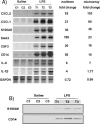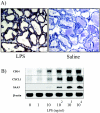Genome-wide expression analysis of lipopolysaccharide-induced mastitis in a mouse model
- PMID: 16495566
- PMCID: PMC1418644
- DOI: 10.1128/IAI.74.3.1907-1915.2006
Genome-wide expression analysis of lipopolysaccharide-induced mastitis in a mouse model
Abstract
To better understand the acute host response to Escherichia coli mastitis, we analyzed gene expression patterns of approximately 23,000 transcripts 4 h after an intramammary infusion of lipopolysaccharide (LPS) in a mouse model. A total of 489 genes were significantly affected, of which 391 were induced and 98 were repressed. Gene ontology analysis demonstrated that most of the induced genes were associated with the innate immune response, apoptosis, and cell proliferation. Substantial induction of the chemokines CXCL1, CXCL2, and S100A8; the acute-phase protein SAA3; and the LPS binding protein CD14 were confirmed by Northern blot analysis. A subsequent time course experiment revealed CXCL1 induction prior to that of CD14 and SAA3. Mammary epithelial cell cultures also showed marked expression of these factors in response to LPS. The expression of immune-related genes in mammary epithelial cells indicates the importance of this cell type in initiating the inflammatory responses. Repressed genes include several carbohydrate and fatty acid metabolic enzymes and potassium transporters, which may contribute to milk composition changes during mastitis. Therefore, the overall transcription profile, in conjunction with gene ontology analysis, provides a detailed picture of the molecular mechanisms underlying the complex biological processes that occur during LPS-induced mastitis.
Figures




Similar articles
-
Immunorelevant gene expression in LPS-challenged bovine mammary epithelial cells.J Appl Genet. 2005;46(2):171-7. J Appl Genet. 2005. PMID: 15876684
-
Transcriptional profiling of the bovine hepatic response to experimentally induced E. coli mastitis.Physiol Genomics. 2012 Jun 1;44(11):595-606. doi: 10.1152/physiolgenomics.00084.2011. Epub 2012 Apr 10. Physiol Genomics. 2012. PMID: 22496490
-
Histone H3K14 and H4K8 hyperacetylation is associated with Escherichia coli-induced mastitis in mice.Epigenetics. 2012 May;7(5):492-501. doi: 10.4161/epi.19742. Epub 2012 May 1. Epigenetics. 2012. PMID: 22419123
-
Cumulative physiological events influence the inflammatory response of the bovine udder to Escherichia coli infections during the transition period.J Dairy Sci. 2007 Jun;90 Suppl 1:E39-54. doi: 10.3168/jds.2006-696. J Dairy Sci. 2007. PMID: 17517751 Review.
-
The toll-like receptor-4 (TLR-4) pathway and its possible role in the pathogenesis of Escherichia coli mastitis in dairy cattle.Vet Res. 2008 Jan-Feb;39(1):5. doi: 10.1051/vetres:2007044. Epub 2007 Nov 20. Vet Res. 2008. PMID: 18073092 Review.
Cited by
-
Mouse models of mastitis - how physiological are they?Int Breastfeed J. 2015 Apr 6;10:12. doi: 10.1186/s13006-015-0038-5. eCollection 2015. Int Breastfeed J. 2015. PMID: 25848399 Free PMC article.
-
Evaluation of the protective effect of bovine lactoferrin against lipopolysaccharides in a bovine mammary epithelial cell line.Vet Res Commun. 2010 Mar;34(3):267-76. doi: 10.1007/s11259-010-9351-z. Epub 2010 Mar 30. Vet Res Commun. 2010. PMID: 20349360
-
Angiopoietin-like protein 2 may mediate the inflammation in murine mastitis through the activation of interleukin-6 and tumour necrosis factor-α.World J Microbiol Biotechnol. 2015 Aug;31(8):1235-40. doi: 10.1007/s11274-015-1873-7. Epub 2015 May 24. World J Microbiol Biotechnol. 2015. PMID: 26003652
-
Staphylococcus aureus and Lipopolysaccharide Modulate Gene Expressions of Drug Transporters in Mouse Mammary Epithelial Cells Correlation to Inflammatory Biomarkers.PLoS One. 2016 Sep 1;11(9):e0161346. doi: 10.1371/journal.pone.0161346. eCollection 2016. PLoS One. 2016. PMID: 27584666 Free PMC article.
-
Escherichia coli infection induces distinct local and systemic transcriptome responses in the mammary gland.BMC Genomics. 2010 Feb 25;11:138. doi: 10.1186/1471-2164-11-138. BMC Genomics. 2010. PMID: 20184744 Free PMC article.
References
-
- Akira, S., and K. Takeda. 2004. Toll-like receptor signalling. Nat. Rev. Immunol. 4:499-511. - PubMed
-
- Badolato, R., J. M. Wang, W. J. Murphy, A. R. Lloyd, D. F. Michiel, L. L. Bausserman, D. J. Kelvin, and J. J. Oppenheim. 1994. Serum amyloid A is a chemoattractant: induction of migration, adhesion, and tissue infiltration of monocytes and polymorphonuclear leukocytes. J. Exp. Med. 180:203-209. - PMC - PubMed
-
- Bansal, B. K., J. Hamann, N. T. Grabowskit, and K. B. Singh. 2005. Variation in the composition of selected milk fraction samples from healthy and mastitic quarters, and its significance for mastitis diagnosis. J. Dairy Res. 72:144-152. - PubMed
-
- Barbosa-Cesnik, C., K. Schwartz, and B. Foxman. 2003. Lactation mastitis. JAMA 289:1609-1612. - PubMed
Publication types
MeSH terms
Substances
LinkOut - more resources
Full Text Sources
Medical
Research Materials

